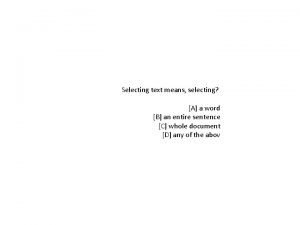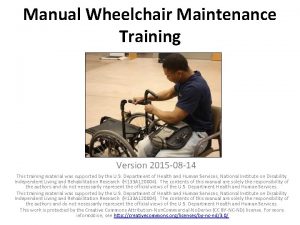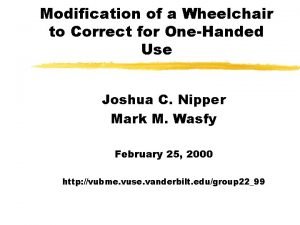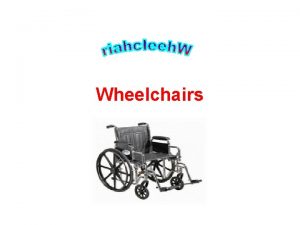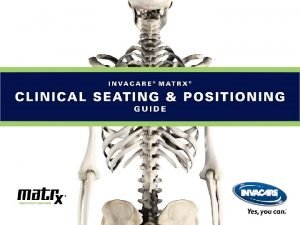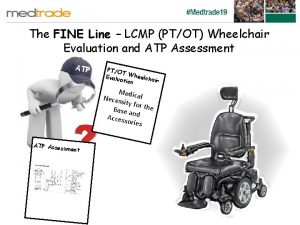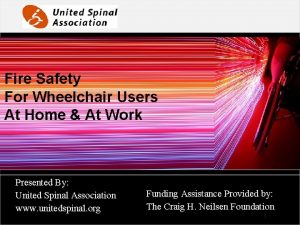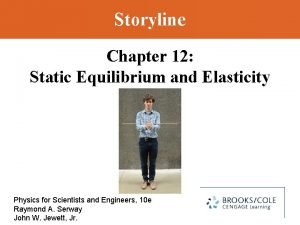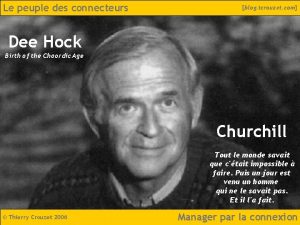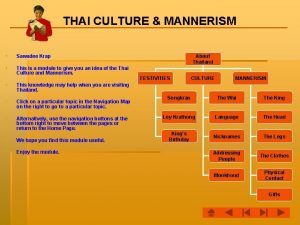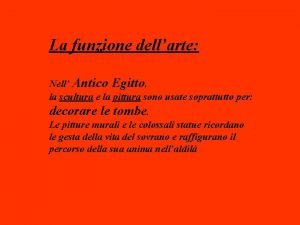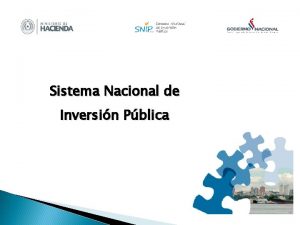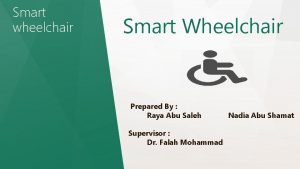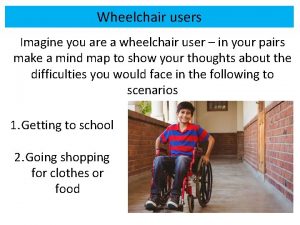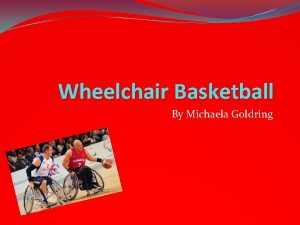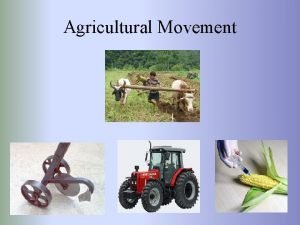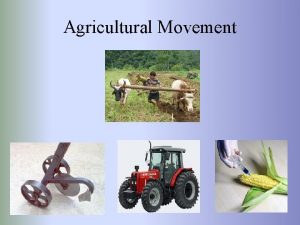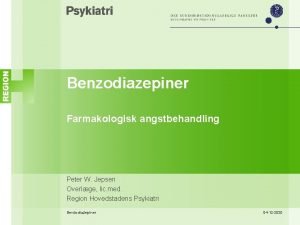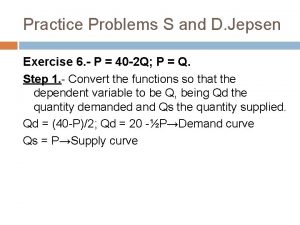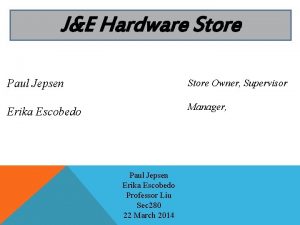Selecting a Wheelchair for Agricultural Use Dee Jepsen
































































- Slides: 64

Selecting a Wheelchair for Agricultural Use Dee Jepsen, Ph. D Brittany Cowgill, OTD, OTR/L

Basic Webinar Instructions • Check sound via Audio>Computer Audio Settings. • Please don’t activate camera. • Closed captions: use arrow to expand the Closed Captions window to view. • Expand/contract any of the windows in the right-hand column with the arrows. • Expand/contract the size of the right-hand column.

Basic Webinar Instructions • Questions and comments • Click Chat icon at top right of screen (it should turn blue). Enter message in box, choose who to send it to, and click send. You may enter questions about the presentation at any time • In addition, during the Q & A period, if you have a web microphone, click the “Raise Hand” icon to indicate that you have a question. We will enable your microphone

Basic Webinar Instructions • 5 quick survey questions + opportunity to share comments • Session recorded and archived with Power. Point files at www. agrability. org/Online -Training/archived • Problems: use chat window or email agrability@agrability. org

Potential Webinar Issues • Audio continues, but slides don’t advance • Move your mouse or hit Enter • Disconnection with presenters ▫ Hang on – we’ll reconnect as soon as possible • Disconnection with participants ▫ Log in again

• Agr. Ability: USDA-sponsored program that assists farmers, ranchers, and other agricultural workers with disabilities. ▫ Partners land grant universities with disability services organizations. Currently 20 state projects ▫ National Agr. Ability Project: Led by Purdue’s Breaking New Ground Resource Center. Partners include: Goodwill of the Finger Lakes The Arthritis Foundation, Heartland Region University of Illinois at Urbana-Champaign Colorado State University ▫ More information available at www. agrability. org

Available at: agrability. osu. edu

Today’s Objectives for the Webinar: 1. Introduce the new bulletin and its contents 2. Identify multiple factors that exist on the farm, and how they affect wheelchair selection 3. Understand the expectations and limitations of the person in the chair, including the chores he or she will tackle 4. Recognize both the common and subtle features of a wheelchair and their impacts on utility The presentation is designed for the chair user, not the service provider.

Evaluating your Environment Identify factors that exist on the farm, and how they affect wheelchair selection

Evaluating your Environment • Needs and Goals • Roles and Routines • Physical and Mental Status • Progression of Disease Processes • Psychosocial Appearance • Compatibility with other Assistive Technology

What to Consider: Where will I be using the wheelchair? • inside or outside • grass, dirt, or concrete What climate will I be in? Evaluating Your Environment

What to Consider: Will stairs or narrow doorways be an issue for me? Will I use it constantly or occasionally? Evaluating Your Environment

More to Consider: Do I need my wheelchair to be compatible with other assistive technology? Do I have a caregiver or will I be independent? Evaluating Your Environment

Evaluating Yourself Understand the expectations and limitations of the person, including the chores he or she will tackle

Current and Future Needs: What are my needs today? What will my needs be in the future? How will my farming operation change in the future? Will my needs change as a result of my farming operation changing? Evaluating Yourself

What types of mobile devices are available? Recognizing the common and subtle features of a wheelchair and their impacts on utility

u. Attendant-Propelled u. Manual Folding vs. Rigid u. Lightweight u. Ultra Lightweight u. Standard-Weight Types of Wheelchairs u. Power u. Manual with Power Unit u. Scooter u. Smart u. Standing

Attendant-Propelled Chairs u Can be used as substitute while power chair is in repair u Pushed by another individual u Talk with caregiver to find a chair that will work for both of you u Can be used full-time Types of Wheelchairs

Manual Chairs u Must be able to brake and propel independently with upper limbs and/or lower limbs u Freedom to tilt -helpful in a farm environment u Flexible u Easy to transport u Various Types: • folding • rigid frame Types of Wheelchairs

Folding Rigid User/caregiver needs ample strength and range of motion for transportation and storage of chair Improved energy efficiency & performance Heavier weight and frame Lighter frame weight Elevating footrests available Limited footrest options available Snap-secure frames Custom ordering from a rehabilitation technology supplier Quick release wheels/ Adjustable front rigging Better for a user who needs to be cautious of energy use Types of Manual Wheelchairs

Lightweight Chairs u Less than 40 lbs. u Intended for full-time users u User needs core body strength and stability to operate chair u Difficult to operate on rough terrain u Ultra Lightweight Chairs • less than 25 lbs. • intended for supplemental use Types of Wheelchairs

Standard-Weight Chairs u Increased weight for improved balance and stability u Come with less custom options u Generally less expensive Types of Wheelchairs

Do I have enough strength, range of motion, and endurance to propel the chair? Do I have enough strength to propel the chair for several hours at a time? Does my caregiver have enough strength to propel the chair? Standard-Weight Chairs

Power Chairs u Most have wheels separate from seating system u Sturdy u Good for full-time users u Works well both indoors and outdoors Types of Wheelchairs

Power Chairs u Additional maintenance and upkeep needed u Batteries: wet cell lead acid and gel-cell lead acid* For agricultural purposes: *Gel-cell lead acid may be a good option -battery cases exposed to weather elements are more likely to be damaged -user is less likely to be injured with a gel-cell lead acid battery if the battery case is damaged u If the power chair breaks down, do you have a backup mobility option? Types of Wheelchairs

Power Chairs u Points to Consider: - Requires cognitive and visual-perceptual ability to operate - Specialized transport requirements: lifts, ramps - Large turning radius - Vehicle needs to accommodate the weight and size of chair Types of Wheelchairs

Manual Chairs with Add-on Power Unit u Allow power unit feature to be engaged or disengaged as needed u “Test drive” of a power chair before committing to the purchase of a real power chair u Power component adds weight to a manual chair Types of Wheelchairs

Scooters u Not intended for full-time use u Used as a supplement to a cane/walker for farther treks such as between barns u Intended for community use Types of Wheelchairs

Scooters u Large turning radius u Difficult to operate: - indoors - In small outdoor spaces such as livestock pens or workshops - Types of Wheelchairs

Smart Chairs Computer or set of sensors attaches at the base of a mobile robot where the seat is attached. Useful chair for those with: Low vision Cognitive impairment Musculoskeletal dysfunction Types of Wheelchairs

Smart Chairs Three Main Functions: 1. Collision avoidance 2. Navigation through environmental barriers 3. Navigation features from place to place Types of Wheelchairs

Standing Chairs u Good option for those with a spinal cord injury or multiple sclerosis u Pressure relief u Improved environmental accessibility u Face-to-face communication with others u More expensive than other wheelchair options u Some can be mobile in an upright position u Large in size Types of Wheelchairs

Manual Power Includes Manual Driven & Manual Lift u Uses hydraulic system with a pump to raise the user to a standing position u User has a support system that uses padded bars to keep them upright Types of Wheelchairs

Half Power Includes Manual Driven & Manual Lift u Manually driven chair that has a button that will automatically move user into a standing position u User has a support system that uses padded bars to keep them upright Types of Wheelchairs

Full Power Includes Manual Driven & Manual Lift u Motorized chairs where the user has a button that will automatically move them into a standing position u User has a support system that uses padded bars to keep them upright Types of Wheelchairs

Fitting your Chair Points to consider for the best fit

Ensuring the best fit u Seat width u Seat depth u Back height u Seat height and leg rests u Armrests Types of Wheelchairs

Seating and Positioning Options for seating surfaces

Planar u for those needing little or no postural support u must be able to reposition themselves easily Seating Surfaces

Pre-Contoured u gives added contact for stability u provides greater pressure distribution Seating Surfaces

Custom Contoured Best option for: - a spine or pelvic deformity - abnormal muscle tone - decreased spinal support Seating Surfaces

Seating and Positioning Adding cushions

Foam Cushions Advantages Lightweight Disadvantages Uneven pressure Easily sized Poor durability Inexpensive Hard to Clean

Gel-filled Advantages Self-contouring Disadvantages Heavy Posture control Temperature sensitive Requires frequent maintenance to prevent leaks Sitting balance Cushions

Air-filled Advantages Lightweight Even pressure Reduced shear forces Cushions Disadvantages Reduced postural control Air leaking is common Requires constant maintenance

Honeycomb Advantages Lightweight Disadvantages Uneven pressure Easy to clean Difficult to fit user Low maintenance Adds thickness to chair Cushions

Customcontoured Advantages Disadvantages High surface area Expensive coverage Reduced shearing Poor longevity forces with biological changes Improved postural Reduced ability to control weight shift Cushions

Alternating Pressure Systems. Advantages Disadvantages Scheduled pressure relief cycle Reduces user effort Self-contouring Cushions Expensive Uneven pressure relief Poor sitting balance

Water-filled Cushions Advantages Self Contouring Disadvantages Heavy Posture Control Prone to Leaks Inexpensive Temperature Sensitive

Tires Important for terrain conditions

Pneumatic (Air-filled) Advantages Disadvantages • Lightweight • Require Regular Maintenance • Good Shock Absorption • Can Extend life of Chair Tires

Semi-Pneumatic (Foam-filled) Advantages • Requires Little Maintenance • Good Cushioning Disadvantages • Wears out quickly Tires

Solid Rubber Advantages • Little Maintenance • Good Cushioning • Low rolling resistance Tires Disadvantages • Adds Weight to Chair

Accessories Important for overall function and independence

Guards u Block clothing from getting stuck in tires u Keep tools/ropes from getting stuck in tires u Can be used on armrests Accessories

Anti-tip Devices u Prevent chair from tipping in - Fields - Livestock Pens u Can be difficult to maneuver in fields and pens Accessories

Lap Trays Can use it as a personal work bench Accessories

Restraining Devices u seat belts, vests, harnesses u can help with neuromuscular impairment Accessories

Recline and Tilt Options u offer rest changes and pressure relief u most attendant-propelled wheelchairs offer u semi-recline and full-recline options Accessories

Final points to consider And where to go for more information

Final Points to Consider • Multi-step process • Requires user to think about themselves, their environment, and features of a wheelchair • Consideration of seating and positioning

Community Resources The National Agr. Ability Project 225 S. University St. West Lafayette, IN 47907 Tel: 1 -800 -825 -4264 http: //agrability. org The Ohio Agr. Ability Program The Ohio State University 590 Woody Hayes Drive Columbus, OH 43210 http: //agrability. osu. edu RESNA The Rehabilitation Engineering & Assistive Technology Society of North America 1700 N. Moore St, #1540 Arlington, VA 22201 Tel: 703 -524 -6686 http: //www. RESNA. org

This presentation was made based on the Ohio Agr. Ability Program’s Wheelchair Bulletin. The following references were used in both the Power. Point presentation as well as the wheelchair bulletin. Batavia, M. The Wheelchair Evaluation: A Practical Guide. Woodburn, MA: Butterworth-Heinemann, 1998. Bolding, D. , C. Adler, and M. Tipton-Burton. “Mobility. ” In H. M. Pendleton and W. Schultz-Krohn (Eds. ), Pedretti’s Occupational Therapy: Practice Skills for Physical Dysfunction (6 th ed. , pp. 233– 294). Philadelphia: Mosby, 2006. Cook, A. M. and J. Miller-Polgar. Cook and Hussey’s Assistive Technologies: Principles and Practice. Philadelphia: Mosby, 2008. Dudgeon, B. J. and J. C. Deitz. “Wheelchair selection. ” In M. V. Radomski and C. A. Trombly Latham (Eds. ), Occupational Therapy for Physical Dysfunction (6 th ed. , pp. 487– 509). Baltimore: Lippincott Williams and Wilkins, 2008. Hobson, D. The Anatomy of a Powered Wheelchair [Power. Point slides]. Retrieved from wheelchairnet. org/wcn_wcu/Slide. Lectures/DAH/Anat. Powered. WCs-0699. pdf. Mc. Keough, D. M. Anatomy of a Manual Wheelchair [Power. Point slides]. Retrieved from wheelchairnet. org/wcn_wcu/Slide. Lectures/Mc. Keough. WCAnat. pdf. National Agr. Ability Project. Secondary Injury Prevention and Farming From a Wheelchair. Purdue University, West Lafayette, IN: Breaking New Ground Resource Center, 2006. Simpson, R. C. “Smart Wheelchairs: A Literature Review. ” The Journal of Rehabilitation Research and Development 42(4), 423– 438, 2005. Retrieved from rehab. research. va. gov/jour/05/42/4/ simpson. html. References

Thank You agrability. osu. edu Dee Jepsen, Ph. D Jepsen. 4@osu. edu Brittany Cowgill, OTD, OTR/L bcowgill 21@gmail. com
 Selecting text means
Selecting text means Jepsen entreprise
Jepsen entreprise Anatomy of a wheelchair
Anatomy of a wheelchair Chapter 15 scalp care shampooing and conditioning
Chapter 15 scalp care shampooing and conditioning Wheelchair basketball
Wheelchair basketball Wheelchair maintenance checklist
Wheelchair maintenance checklist One handed wheelchair
One handed wheelchair Average wheelchair size
Average wheelchair size Wheelchair backrest for scoliosis
Wheelchair backrest for scoliosis National rugby league
National rugby league Atp wheelchair evaluation
Atp wheelchair evaluation Wheelchair fire escape
Wheelchair fire escape Static equilibrium and elasticity
Static equilibrium and elasticity Von thunen model graph
Von thunen model graph Von thunens model
Von thunens model Model von thunen
Model von thunen Dee ward hock
Dee ward hock Dee magnoni
Dee magnoni Swadee kap
Swadee kap Tre dee alla scuola media riassunto
Tre dee alla scuola media riassunto Little star in korean
Little star in korean Artvnow
Artvnow Dee simmons young
Dee simmons young Dee horton and lew hewitt
Dee horton and lew hewitt Micerino tra due dee
Micerino tra due dee Frankie dee brown
Frankie dee brown Dee hock
Dee hock Conversational dashboard
Conversational dashboard Klein anna zat op blauwe steen
Klein anna zat op blauwe steen Dee williams anal fuck
Dee williams anal fuck Topical agents are
Topical agents are Dac dee fly
Dac dee fly Dee w hock
Dee w hock Dr dee-ann carpenter
Dr dee-ann carpenter Dee kay buildcon pvt ltd
Dee kay buildcon pvt ltd Casperwww.
Casperwww. Giz dee
Giz dee Jane dee hull elementary
Jane dee hull elementary Dee childs
Dee childs Dga energy
Dga energy Dee trader opens a brokerage account
Dee trader opens a brokerage account Preinversion
Preinversion Egg för emanuel
Egg för emanuel Tack för att ni lyssnade bild
Tack för att ni lyssnade bild Bris för vuxna
Bris för vuxna Chapter 7 selecting the channel members
Chapter 7 selecting the channel members Personlig tidbok för yrkesförare
Personlig tidbok för yrkesförare Selecting investment in global market
Selecting investment in global market Matematisk modellering eksempel
Matematisk modellering eksempel Selection criteria for international assignments
Selection criteria for international assignments Sju principer för tillitsbaserad styrning
Sju principer för tillitsbaserad styrning Rutin för avvikelsehantering
Rutin för avvikelsehantering Etik och ledarskap etisk kod för chefer
Etik och ledarskap etisk kod för chefer Mjälthilus
Mjälthilus Strategi för svensk viltförvaltning
Strategi för svensk viltförvaltning Nyckelkompetenser för livslångt lärande
Nyckelkompetenser för livslångt lärande Vad är densitet
Vad är densitet Toppslätskivling dos
Toppslätskivling dos Selecting investment in global market
Selecting investment in global market Selecting channel members
Selecting channel members Standardavvikelse
Standardavvikelse Varför kallas perioden 1918-1939 för mellankrigstiden?
Varför kallas perioden 1918-1939 för mellankrigstiden? Pitfalls in selecting new ventures
Pitfalls in selecting new ventures Referatmarkeringar
Referatmarkeringar People differentiation
People differentiation
